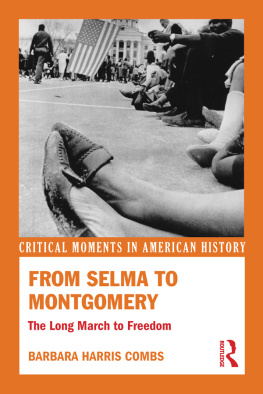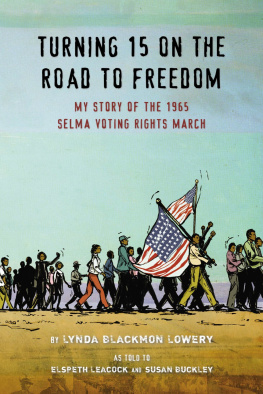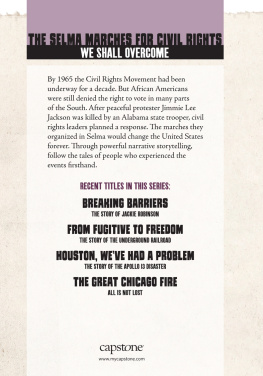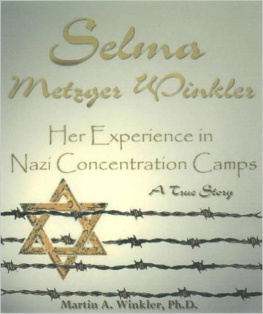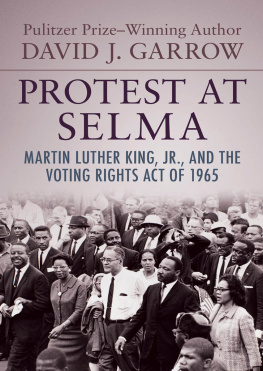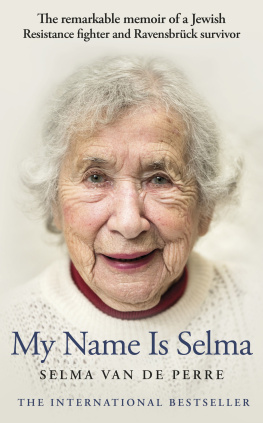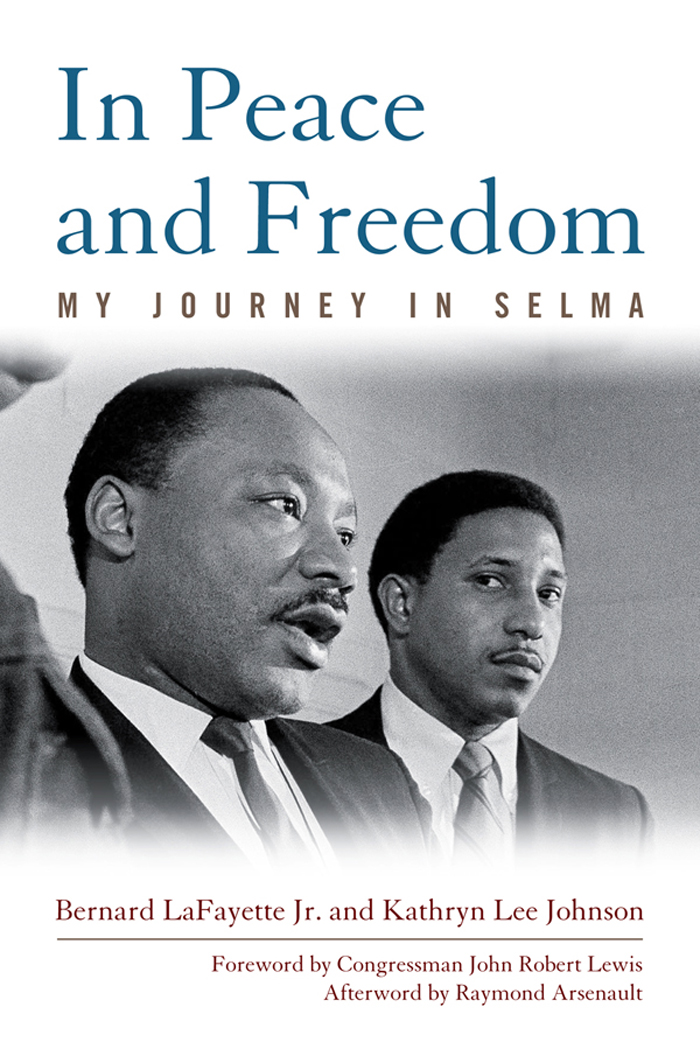Abbreviations
AME | African Methodist Episcopal |
CORE | Congress of Racial Equality |
NAACP | National Association for the Advancement of Colored People |
SCLC | Southern Christian Leadership Conference |
SNCC | Student Nonviolent Coordinating Committee |
SRC | Southern Regional Council |
Acknowledgments
I wish to express deep appreciation for those of you who played a role in making this book a quality documentary that will contribute to the rich history of the civil rights movement and nonviolent struggle that occurred in Selma, Alabama. To the courageous people of Selma, this book was inspired by you and is for you. George Bulls II, this publication would not have happened without your consistent and tenacious efforts. Your untiring and generous labor made it possible to execute the details necessary for the timely publication. Sam Walker from the National Voting Rights Museum in Selma, I value your assistance in obtaining some essential photographs and material that enhanced this publication. Many, many thanks, Professor Paul Bueno de Mesquita, director of the University of Rhode Islands Center for Nonviolence and Peace Studies, for sage advice and astute recommendations, and for giving up time with your wife for endless hours through three years while Kay and I worked together on this memoir.
At the University Press of Kentucky, a shout to Bailey Johnson for your bighearted spirit and for always answering questions immediately. Anne Dean Watkins, what a positive force you are. You patiently waited for us to complete the manuscript and were a powerful advocate for this bookyou are the best. Cynthia Fleming, we owe a great debt to you for the constant guidance and wisdom as you read several drafts and nudged us to be our best. Connie Curry, you not only were a remarkable mentor to me in the 60s but have continued to inspire me for more than fifty years. Your comments and suggestions on the manuscript were immensely helpful. Finally, an enormous thank-you to our family and friends who encouraged and supported us in infinite ways. We can never express enough the boundless appreciation that fills our hearts.
This book is dedicated to the four women who have had the most important influence on my life: three in my earlier years, and one who has influenced me for the past forty years and continues to do so.
First, my maternal grandmother, Rozelia Forrester, lovingly known as Ma Foster, a woman who was independent, daring, courageous, wise, generous, and a firm disciplinarian. She was a businesswoman and a devout Christian home missionary who owned and operated a grocery store and small animal farm. She helped to found a church, the New Hope Missionary Baptist Church in Tampa, and built a congregation. She was my teacher and spiritual mentor, and she played a great role in my pursuit of higher education.
Second is my mother, Verdell LaFayette, who treated me special from birth. Her love and prayers brought me through when times seemed impossible. Sometimes she was like a big sister, other times an imitation of my grandmother. Since she knew me so well, she knew what strategy would get me to do what she wanted me to do. My grandmother got me into college, but it was my mother who motivated me to finish it. She used what I call negative inspiration. Shed tell me, You will never finish college. I would reply, Yes, I will. Shed say, Oh, no, you wont. I was determined to prove her wrong, which was what she wanted me to do. I was in and out of college for years, but eventually I handed her a doctoral degree from Harvard University. We both won.
The third was Amelia Boynton, who inspired me to take on one of the most difficult challenges in my life: Selma, Alabama. She encouraged me and stood by me, and every day she was a glowing example of courage, quiet defiance, and determination, and a reservoir of generosity. I knew every moment I was in Selma that I was not alone, and what better mentor could one have than Mrs. Amelia Boynton? Her leadership was similar to that of Dr. Martin Luther King Jr., bringing others to the forefront and then standing with them. It was her eternal optimism and hope that made the Selma movement possible. She helped me to grow from a young college student to a man in a short period. When one has to make decisions that will determine life or death, one understands what adulthood and manhood are all about.
Finally, my loving wife, Kate Bulls LaFayette. Because of her, I was able to hand my mother my terminal higher education degree. She supported me in every way and encouraged me even when I had doubts about completing my education. She made it possible for me to support my two sons, James Arthur and Bernard III, during their early years and stages of development. Because of her background in early childhood education, she could relate to them, not only as a stepmother but as a molder of values and character. Kate has worked with me, has walked with me, and has sometimes waited patiently for me until I caught up. Without her I would not have been able to accomplish the many goals in my life and would not be able to achieve my purpose for the future. Her love, her strengths, her wit, and her wisdom have made my pilgrimage in life an exciting yet peaceful adventure. How sweet it is! Thank you, Kate. I love you.
Afterword
Bernard LaFayette Jr.s riveting account of his experiences in Selma reminds us that the realization of Americas democratic ideals has rarely involved an easy or uncontested march to victory. During the 1960s, civil rights activists in the Deep South faced powerful adversaries determined to defend the traditions and shibboleths of racial privilege and prejudice by any and all means. Part of the problem, as this book reveals in fascinating detail, resided in personal and political chicanery, but the movement for democratization and racial justice also had to deal with institutional inertia and a pervasive popular complacency. Before meaningful change could occur in the lives of African Americans, the structural bulwarks of disfranchisement and second-class citizenship had to be confronted and identified in dramatic fashion, highlighted in a way that would disrupt and confound long-standing political and social conventions. As we have seen, this instrumental drama was exactly what Bernard LaFayette and others accomplished in Selma.
In the late winter of 1965, a full ninety-five years after the passage of the Thirteenth Amendment, the struggle to secure the voting rights guaranteed by that amendment finally commanded national attention. The epicenter of the struggle was a small Black Belt Alabama town where hundreds of nonviolent activists were beaten by state and local police, and where thousands more ultimately gathered for a protest march to the state capitol in Montgomery. By the time President Lyndon Johnson signed the Voting Rights Act into law in late July, Bloody Sunday and the Selma to Montgomery March had become iconic elements of the civil rights saga. All of this took much of the nation by surprise. Before the dramatic events that unfolded on the Edmund Pettus Bridge and on the road to Montgomery, few Americans had ever heard of Selma, and no one outside of the civil rights movements inner circle knew any of the backstory that had precipitated the Selma crisis.
That backstorythe long-hidden, behind-the-scenes struggle to generate and sustain the local Selma movementis the subject of Bernard LaFayette Jr.s remarkable memoir. Though only twenty-two years old when he arrived in Selma in the fall of 1962, LaFayette was already a seasoned veteran of the civil rights struggle. In 1959 and 1960, at the age of nineteen, he had become deeply involved in the Nashville Student Movement, attending nonviolence workshops conducted by Rev. James Lawson and joining other student activists, including several of his classmates at the American Baptist Theological Seminary, in a series of sit-ins and protest marches. In May 1961 he became a Freedom Rider, boarding a series of buses in Alabama in a brave effort to test compliance with two U.S. Supreme Court decisions mandating the desegregation of interstate travel. Arrested in Jackson, Mississippi, he became one of more than three hundred Freedom Riders incarcerated in Parchman Prison during the spring and summer of 1961. Following his release from prison in early July, he, unlike most Freedom Riders, remained in Mississippi, where he helped James Bevel and Diane Nash to organize the Jackson Nonviolent Movement. This effort, which involved recruiting black teenagers, led to an arrest for contributing to the delinquency of minors. After being convicted and released pending an appeal, he resumed his involvement in the Mississippi civil rights struggleediting the Jackson movement newsletterand in the wider politics of the Student Nonviolent Coordinating Committee (SNCC).


